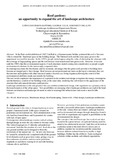| dc.contributor.author | Constantinidis, Elpiniki | |
| dc.contributor.author | Georgi, Neratzia Julia | |
| dc.contributor.author | Declan, Rafferty | |
| dc.date.accessioned | 2016-04-19T14:38:10Z | |
| dc.date.available | 2016-04-19T14:38:10Z | |
| dc.date.issued | 2009 | |
| dc.identifier.isbn | 978-960-474-125-0 | |
| dc.identifier.issn | 1790-5095 | |
| dc.identifier.uri | http://hdl.handle.net/11728/7527 | |
| dc.description.abstract | In the Paris world exhibition of 1867 Carl Rabitz, a German master builder, patterned the roof of his own villa to extend the functional space in the building design. The flattened roofs and the extra space given to the appartment was used for amenity. In the 1970’s, people started appreciating the value of alternating the cityscape with the coverage of large parking spaces and the roof terraces were transformed into green roofs. However, it was not until the 1980’s that the environmental aspects of such structures started coming into consideration as people sought environmental solutions for the increasingly congested cities. In contemporary times the bioclimatic and the economic advantages that the green roofs provide to buildings have become an integral part of their design. Roof terraces are not positioned any more on the top of a structure, they are the structure and together with other structural matters function as a living organism allowing the control of the
environmental attributes inside and outside the building. The new trends emphasize the importance of vegetation in the architectural design to regulate the energy consumption and the thermical comfort of the building while, at the same time, rendering that soft texture to the appearance of the
structure that only natural elements could provide.
Landscape architecture as the only practice that can combine architectural design with vegetation has a primary role in
the transformation of the urban space. New possibilities are emerging where landscape architects can exploit the bond
between architecture and landscape elements in order to rearrange the urban texture and create a more livable
cityspace. | en_UK |
| dc.language.iso | en | en_UK |
| dc.relation.ispartofseries | Proceedings of 5tth International Conference on Enegry, Environment, Ecosystems and Sustainable Development; | |
| dc.rights.uri | http://creativecommons.org/licenses/by-nc-nd/4.0/ | en_UK |
| dc.subject | Roof terraces | en_UK |
| dc.subject | Bioclimatic design | en_UK |
| dc.subject | Roof landscaping | en_UK |
| dc.subject | Green roofs | en_UK |
| dc.subject | Urban design | en_UK |
| dc.subject | Landscape architecture | en_UK |
| dc.title | Roof gardens: an opportunity to expand the art of landscape architecture | en_UK |
| dc.type | Working Paper | en_UK |


